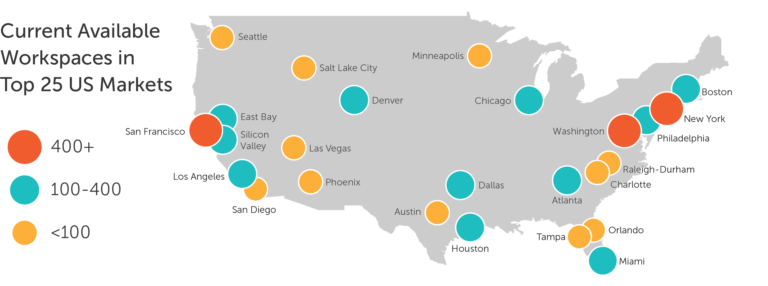LiquidSpace Report: Flexible Office Space Demand is Growing
CREtech Blog

The modern workplace has evolved beyond business parks and cubicle mazes. Businesses demand workspaces flexible in terms of size, location, amenities, and leasing terms. Liquidspace, a leading provider of flexible office space, conducted an analysis of its marketplace in the final quarter of 2016 to pinpoint current and future demands. Their conclusion: more providers recognize the need for flexible terms and flex space needs will continue increasing.
Any commercial space rented less than on a five or 10-year lease is considered a flexible workspace. LiquidSpace offers rentals on hourly, daily, monthly, and extended year terms, but for the purposes of their report, they focused on leases ranging from one month to three years. Their discovery? Companies want shorter rental and lease terms.
Top Drivers of Office Space Demand
Technology firms are driving the flexible office space demand, driving 41% of LiquidSpace’s leases last year. The rising cost of living in two popular tech centers, San Francisco and New York, plus climbing new construction costs, is influencing the way tech companies attract the best talent. Offering flexible workspace and alternative offices is a popular solution. Consultants came second, representing a quarter of the flexible office use booked on LiquidSpace. Finance, media and real estate professionals rounded out the top five sectors seeking flexible workspace. For these types of startups and entrepreneurs, it's difficult to think in terms of a five or 10-year lease.
What Businesses Want in Office Space
The report identified another shift in how businesses think about office space. Millennials prefer more cultural amenities, collaboration, and sharing. Modern workers come with their own technological tools and are less dependent on having specific equipment set up in a particular space. This means that companies see office space as a strategic branding opportunity to attract talent, not as a necessary commodity.
Office Space Size Demands Vary
Demand for flexible working conditions is not limited to small teams or startups. While 61% of LiquidSpace’s users represented teams of less than four, 12% came from teams seeking space for over 15 workers. While not providing numbers, the report states that there are companies seeking to accommodate over a hundred employees with flexible office leases.
Office Space Providers
Flexible Workspace-as-a-service, alternatively known as co-working, remains popular, but new competition is on the horizon. Liquidspace reports an increase in the number of traditional businesses and private landlords offering more flexible office space. Over 30% of the public listings available in the last quarter of 2016 came from private businesses and 7% were direct landlords. Liquidspace expects these numbers to grow and compete against Waas providers.
Download the LiquidSpace Q4 2016 report for a closer look at additional flexible office space trends. See where these types of workspaces are growing and the potential industry changes for 2017.
